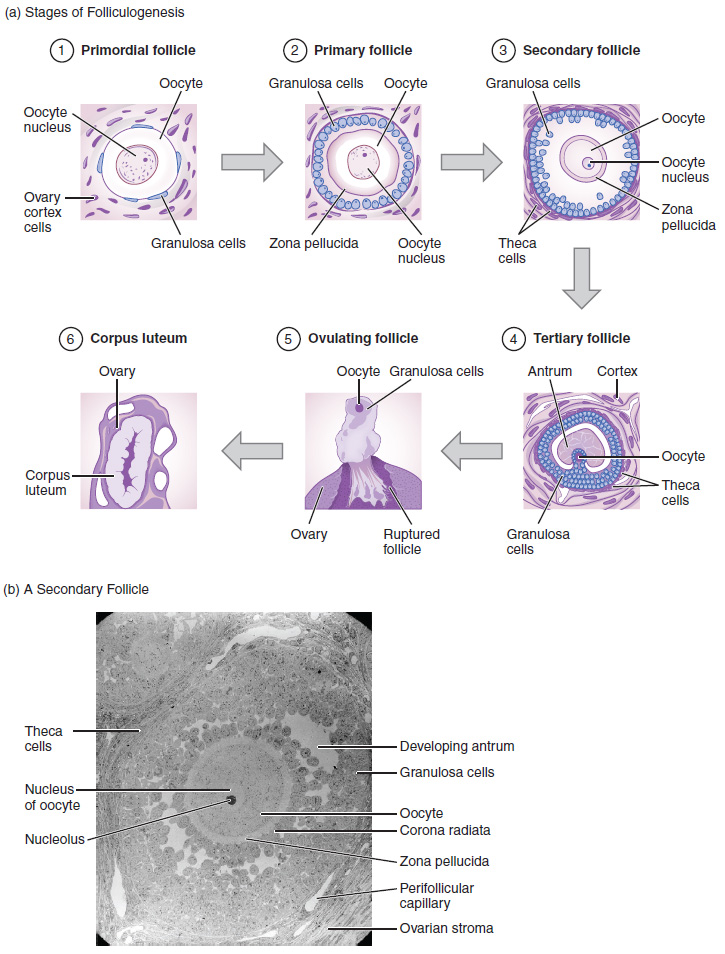
LH spikes before FSH spikes during ovulation.
Image attribution:
Creative Commons Attribution License v4.0
https://openstax.org/details/books/anatomy-and-physiology
Menstrual Phases
The menstrual cycle will be divided into 4 phases to simplify timing: menses (menstruation), proliferative, secretory and premenstrual. Ovulation is between proliferative and secretory phases, and it will be considered an intermediate time.
Follicular phase has been divided up into menstruation and proliferative phases. Menstruation is when the uterus lining is shed. The proliferative phase is from the end of menstruation until ovulation: this is the time when the uterus rebuilds to prepare for potential pregnancy.
Luteal phase has been divided into secretory and premenstrual phases. The corpus luteum which produces progesterone is present during the secretory phase. Premenstrual phase begins after the corpus luteum disintegrates, and it ends at the beginning of menstruation.
In a simplified herb schedule, any time outside of menses will be considered non-menses. It will include all phases and intermediary times outside of menses.
Determining Menstrual Phase
Temperature is often used as an indicator, but sometimes abnormal temperatures can give false indications of phase. Mucus is a more reliable way to determine phase. If one is unsure of phase, it is better to wait a day or two after taking any herbs or other supplements before trying to determine phase. Temperature can fluctuate soon after herbs are taken, and phyto-hormones can affect mucus.
For images of cervical mucus throughout the cycle for reference, see: Cervical mucus: What it looks like through your cycle. For more description, see: How does cervical mucus change during menstrual cycle?. See the links under resources for more.
Menses
Menses (menstruation) is determined by menstrual shedding.
Proliferative
Proliferative phase begins once menstruation stops. Sometimes, menstruation can stop for a day, then resume. This phase is when estrogen levels gradually start to rise.
At the beginning of proliferative, when estrogen levels are low, there is an absence of cervical mucus. A good indication of being definitely a few days into proliferative phase is when mucus starts.
Mucus starts off as thick and sticky. Then, increasing estrogen levels and response influences mucus to become clear and watery during late proliferative phase before ovulation.
Temperature for proliferative phase normally ranges from 36.2°C (97.2°F) to 36.5°C (97.7°F).
Ovulation
Increased cervical mucus that is clear or semi-transparent (like raw egg white) and stretchy/stringy is an indication of ovulation. Swollen genitals and a feeling of itching near where the ovaries are located are sometimes associated with ovulation.
For more on signs of ovulation, see: 10 Signs of Ovulation.
Secretory
Thick (creamy) unclear (white/yellow) mucus and higher body temperature are signs of secretory phase.
Dominant progesterone levels cause mucus to be thick and unclear.
Temperature for secretory phase normally ranges between 36.5℃ (97.7℉) to 37℃ (98.6℉). Progesterone produced by the corpus luteum in comparison to lower estrogen raises body temperature. If body temperature is significantly higher than 37℃ (98.6℉), or if you have hot-flashes, see estrogen response.
Premenstrual
Premenstrual syndrome symptoms are likely from a sudden decrease in progestogen synthesis. Here, body temperature lowers under 36.5℃ (97.7℉).
Mucus remains thick during premenstrual. It gets gooey and cheesy-like closer to menstruation.
Birth control pills
When birth control pills (BCP) are used, there may not be ovulation and possibly secretory phase.
Lunar Calendar

≈ 47% illuminated
22 days old
waning
UTC 2025 Jan 22
Menstrual phases can synchronize with the Moon's phases, but it is not always so. The beginning of menstruation is associated with New Moon, and the occurance of full moon is associated with ovulation. This is a less reliable way of determining menstrual phases.
| 2025 Menstrual Calendar | |||||||
|---|---|---|---|---|---|---|---|
| New | 1Qtr | Full | 3Qtr | ||||
| Dec 30 | Jan 6 | Jan 13 | Jan 21 | ||||
| Jan 29 | Feb 5 | Feb 12 | |||||
| Menses / Proliferative | Ovulation | Secretory / Premenstrual | |||||
| 2025 January 22 UTC | |||||||
Symptoms
The symptom of hot-flashes is associated with abnormally high body temperature. Hot-flashes can indicate an estrogen imbalance.
Diagrams of folliculogenesis

https://openstax.org/details/books/anatomy-and-physiology
Breast.is blog
References:
- Menstruation. Encyclopedia Britannica. 2017. https://britannica.com.
- Physiology, Ovulation. https://www.ncbi.nlm.nih.gov/books/NBK441996/.
- Ovulation, a sign of health. https://www.ncbi.nlm.nih.gov/pmc/articles/PMC5730019/.
- Cervical Mucus Before Period. https://www.pregnanteve.com/cervical-mucus-period/.
Resources:
- Menstrual Cycle - Proliferative Phase, Secretory Phase, Menstruation. JRank. http://science.jrank.org/pages/4235/Menstrual-Cycle.html.
- How to Predict Ovulation by Charting Your Basal Body Temperature and Cervical Mucus. Baby Center. https://www.babycenter.com/chart-basal-body-temperature-and-cervical-mucus#articlesection3.
- What cervical mucus looks like through your cycle. https://www.babycenter.com/101_what-cervical-mucus-looks-like-through-your-cycle_10351429.bc.
- How does cervical mucus change during menstrual cycle?. https://www.pregnanteve.com/cervical-mucus-period/.
- 10 Signs of Ovulation. https://www.justmommies.com/articles/signs-of-ovulation.shtml.
